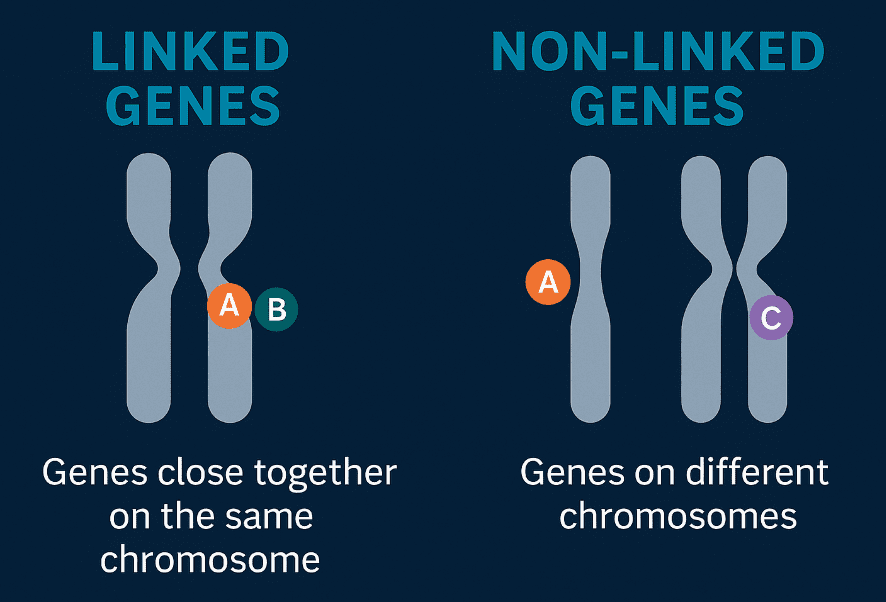Linkage and Crossing Over in Genetics
Understanding chromosome behavior and genetic recombination
Linkage and crossing over are fundamental genetic phenomena that explain how genes are inherited together or separately. For NEET, JEE, and CBSE Class 12 Biology students, these concepts are crucial for understanding inheritance patterns that deviate from Mendel’s laws. This guide explores chromosome linkage, the mechanism of crossing over, and their significance in genetic diversity.
Key Concept: Linked genes on the same chromosome tend to be inherited together, while crossing over creates new gene combinations during meiosis.
What is Genetic Linkage?
Genetic linkage refers to the tendency of genes located close together on the same chromosome to be inherited together during meiosis. This occurs because:
- Genes are physically connected on the chromosome
- They don’t assort independently (violating Mendel’s Law of Independent Assortment)
- The closer two genes are, the stronger their linkage
Morgan’s Linkage Experiment
Thomas Hunt Morgan’s work with Drosophila showed:
Eye color (white/red) and wing size (vestigial/normal) genes were inherited together more often than expected
This demonstrated genes exist on chromosomes and can be linked
Types of Linkage
Complete Linkage
- Genes are extremely close on chromosome
- Always inherited together
- No recombinants formed
- Example: AB/ab produces only AB or ab gametes
Incomplete Linkage
- Genes are farther apart on chromosome
- Some recombinants formed due to crossing over
- Example: AB/ab produces mostly AB, ab but some Ab, aB
- Frequency of recombinants indicates distance
Crossing Over Mechanism
Process Overview:
- Occurs during prophase I of meiosis
- Homologous chromosomes pair up (synapsis)
- Non-sister chromatids exchange segments at chiasmata
- Results in new combinations of alleles
Stages of Crossing Over
1. Synapsis
Homologous chromosomes pair up precisely gene by gene
Zygotene stage of prophase I
2. Tetrad Formation
Each homologous pair becomes a bivalent (4 chromatids)
Pachytene stage
3. Crossing Over
Non-sister chromatids break and rejoin at chiasmata
Diplotene stage
Importance of Crossing Over
Genetic Variation
- Creates new allele combinations not present in parents
- Provides raw material for natural selection
- Explains why siblings (except identical twins) differ genetically
Chromosome Mapping
- Crossing over frequency indicates gene distance
- 1% recombination = 1 map unit (centiMorgan)
- Used to create genetic linkage maps
Linkage vs. Crossing Over
| Aspect | Linkage | Crossing Over |
|---|---|---|
| Effect | Keeps genes together | Separates linked genes |
| Genetic Result | Parental combinations | Recombinant combinations |
| Occurrence | Always present | During meiosis only |
| Frequency | Higher for closer genes | Higher for distant genes |
FAQs About Linkage and Crossing Over
1. Why don’t linked genes follow Mendel’s law of independent assortment?
Because they’re physically connected on the same chromosome and tend to move together during meiosis.
2. How does distance between genes affect crossing over?
The farther apart two genes are, the more likely crossing over will occur between them, increasing recombinant frequency.
3. Can crossing over occur between sister chromatids?
No, it only occurs between non-sister chromatids of homologous chromosomes during meiosis.
4. What is the relationship between chiasmata and crossing over?
Chiasmata are the physical manifestations where crossing over has occurred between chromatids.
5. How is linkage detected experimentally?
By observing deviation from expected 9:3:3:1 dihybrid ratio – more parental types than recombinants.
6. What is the significance of 50% recombination frequency?
It indicates genes are either on different chromosomes or far apart on same chromosome, behaving as if unlinked.
7. How does crossing over contribute to evolution?
By creating new gene combinations that natural selection can act upon, increasing genetic diversity.
8. Can linkage be complete in humans?
Very rarely – most genes show some recombination due to chromosome length, except for very closely linked genes.
Summary of Key Points
- Linkage keeps genes on same chromosome together during inheritance
- Crossing over exchanges segments between homologous chromosomes during meiosis
- Recombination frequency is used to map gene positions on chromosomes
- Complete linkage produces only parental types, incomplete linkage produces recombinants
- These processes explain deviations from Mendelian inheritance ratios
- Crucial for understanding genetic diversity and chromosome mapping
Explore More Genetics Concepts
Dive deeper into chromosome structure, Mendelian genetics, and mutation theories!
